maozhang.net
Statues
During the Cultural Revolution thousands of larger-than-life statues of Mao were erected throughout China, with more than 900 in the Tianjin area alone. Mao had previously vetoed statues of himself or other leaders, but the revolution did not always proceed in accordance with the Chairman's wishes.
The first large statue of Mao was created by Jinggangshan Red Guards at Qinghua University. Symbolically completed on 1st May 1967, it was made of concrete and stood 7.1 metres tall. The height was deliberately chosen to signify July 1st, the founding date of the CCP. Exactly one month later, Red Guards at Beijing University unveiled a rival statue that was one metre taller. Within weeks hundreds of statue projects were begun in cities across the country. Beijing Mining Institute produced a cast aluminium statue 7.1 metres tall and placed it on a plinth 5.16 metres tall (signifying the May 16th directive). The combined height of the statue and plinth was 12.26 metres, which not only represented Mao's birthday, but also the date of the statue's unveiling on 26th December 1967.
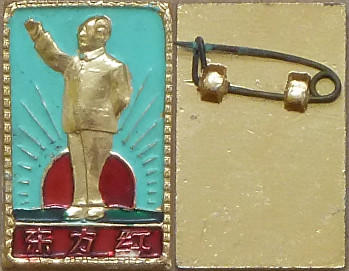
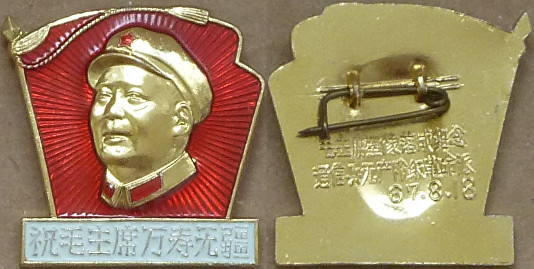
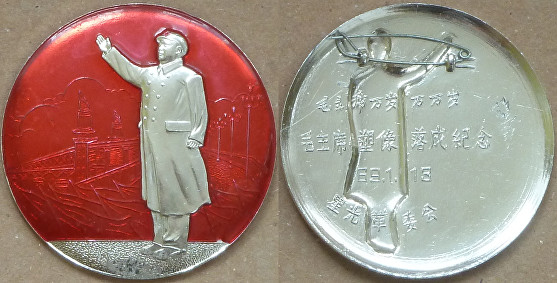
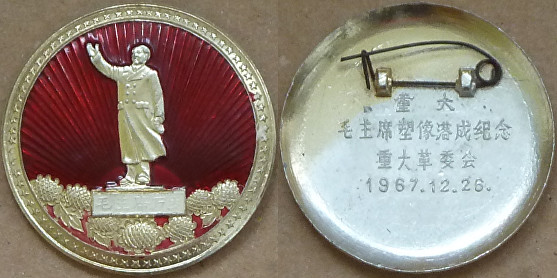
h. 30mm w. 19mm 2.4g
The numerology of Mao statuary that had evolved in Beijing by the end of 1967 established a widely copied model. A height of 12.26 metres became fairly standard, although other heights were permissible; for example 10.1 metres signified the date of the founding of the PRC.
On 18th June 1967 Lin Biao instructed that large statues of the Chairman should be constructed at, "All representative military institutions that have a large courtyard or square".
The badge at left, issued by Signal Corps Proletarian Revolutionaries, commemorates the completion of one of these PLA statues.
"The strongly voiced request of the broad revolutionary masses to erect Chairman Mao statues truly derives from their unlimited hot love towards the great leader Chairman Mao. But, creating Mao Zedong statues is a grave political question."
Zhongfa 219, 13th July 1967
h. 28mm w. 28mm 3.0g
One result of Zhongfa (67) 219 was that all proposed statues had to be vetted and approved by the Centre. Consequently the pace of statue-building slowed somewhat until it revived during the spring and summer of 1968, driven by the enthusiasms of newly formed revolutionary committees.
The badge at right commemorates the inauguration of a Mao statue at the beginning of 1969. By this time provincial-level revolutionary committees had been established throughout the country, hence the sea of red flags in the lower background. The location of the issuing revolutionary committee is uncertain. The bridge in the upper background may identify Nanjing.
53mm 10.2g
38mm 5.4g
The badge at left commemorates the establishment of the Chongqing University Revolutionary Committee and the inauguration of the university's Mao statue, which conformed to a local numerology.
The statue was 9.15 metres tall and was accompanied by eight flagpoles each 8.15 metres in height. The main Red Guard faction at the university was the August Fifteenth (8.15) Battle Group, some members of which had attended the mass rally in Tiananmen Square on 15th September (9.15) 1967. Although the badge is dated 26th December, an eyewitness recalls that the establishment and inauguration actually took place one day later on 27th December.
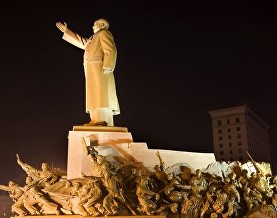
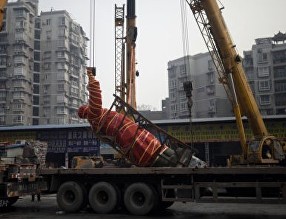
Postscript
Mao statues have had a chequered history since the end of the Cultural Revolution. Some have been preserved as treasured landmarks; many have been removed, for both political and practical reasons, sometimes in the face of popular protest; and a few have been built quite recently.
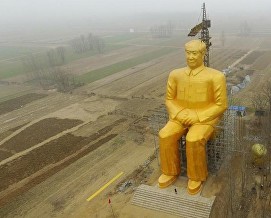
"Mao Zedong's statue, of course, is not a work of art, but a special religious building. Religious architecture always needs to make people feel mysterious and noble, its shape, structure and size, always filled with metaphors and symbols."
Zhou Ziren, former Chongqing Red Guard and editor of August Fifteenth Battle News
This 36-metre statue in Hunan was completed in December 2016, but was torn soon afterwards following public ridicule and official objections.
This Mao statue was carefully wrapped in red cloth before being relocated from Shapingba district in Chongqing to a newly constructed museum.
This statue, entitled Long Live the Victory of Mao Zedong Thought and completed in 1970, still graces Zhongshan Square in Shenyang.
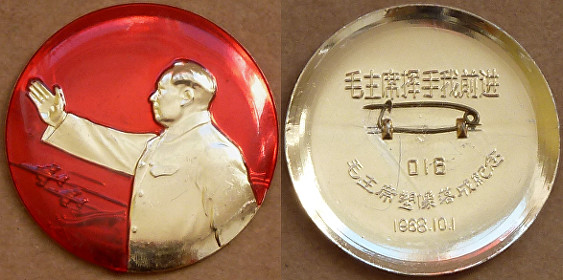
This badge commemorates a statue of Mao inaugurated on National Day 1968, and it is a reasonable assumption that the statue stood 10.1 metres tall.
The upper part of the reverse inscription reads, "Chairman Mao called me forward".
The numerals 061 refer to the issuing authority, most likely an airforce unit.
48mm 8.2g